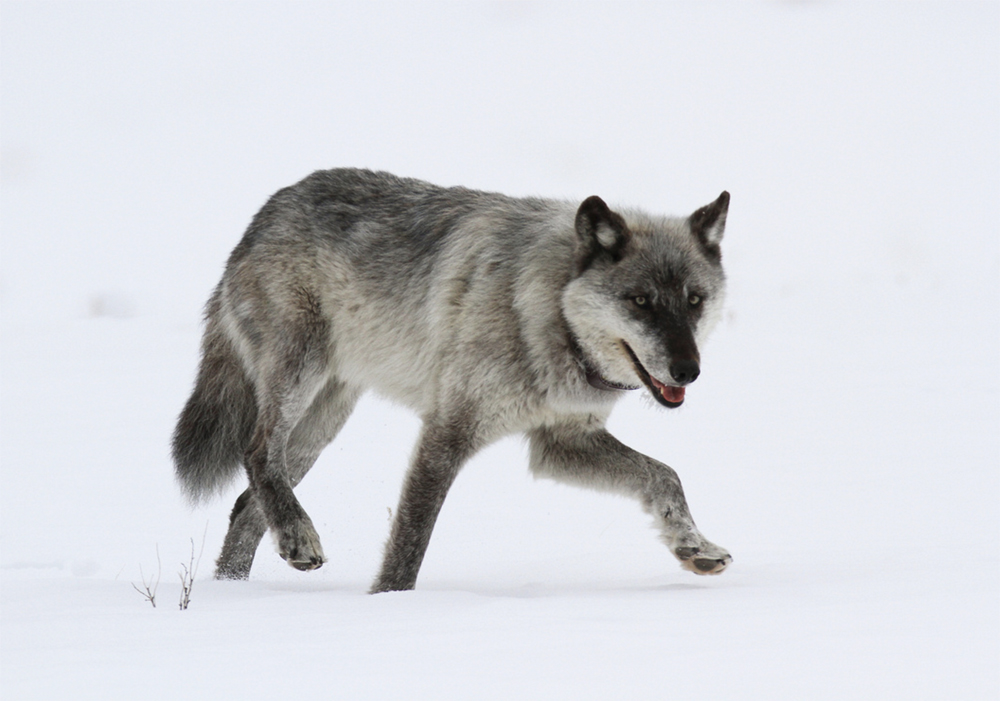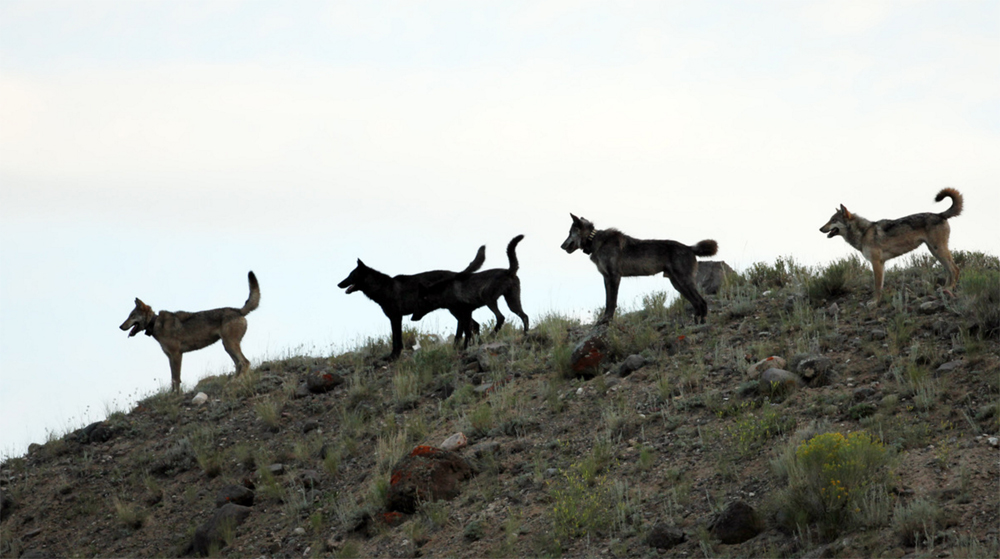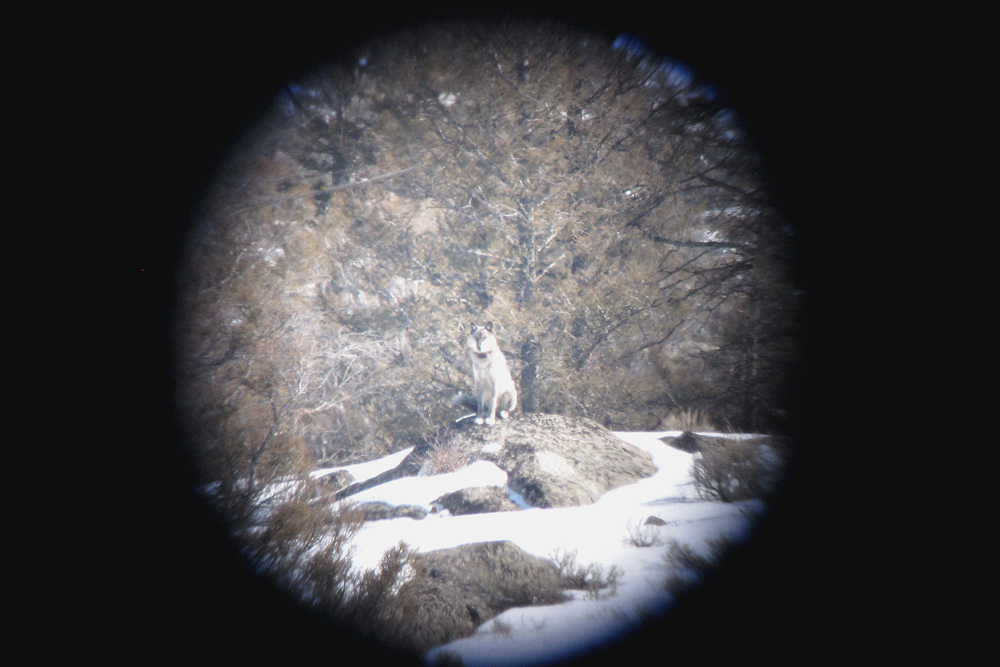Male #755: The Wolf With Nine Lives
He’s lost everything a wolf can lose, and still this resilient Yellowstone male thrives.
By Carl Safina
Guest contributor

Wolf 755. He had lost his brother, his mate, and his territory as a brutal winter was setting in. But he surprised everyone with his resilience…and luck. Photo: Alan Oliver.
Eight years is a very long time to be a Yellowstone wolf; average life expectancy is only about 4. To avoid fatal injury while hunting elk, to endure gang-like fights with rival packs, to evade the human enemies who ring the park, to cope with the loss of your family—to do all this and survive eight years is exceptional.
Meet an exceptional wolf known as “755.” (His research collar number is his name.) He’d lost essentially everything a wolf can lose—except his life. Yet he’s put his pieces back together.
I would have bet against him. His survival seems a near miracle. But wolves don’t get miracles. They get luck. He’s had a lot of luck—most of it bad. Yet he’s thriving.
I chronicled the tumult of his early life in my book “Beyond Words,” in which the true stories of real wolves, elephants, orcas and others reveal them as individuals whose lives matter deeply to them. Dedicated wolf watchers Laurie Lyman and Doug McLaughlin have helped update me on recent events in the life one particularly amazing wolf. Here’s his story.
Years ago, as clumsy and hapless young two-year-old wolves, 755 and his brother got their big break in life. They met an extraordinary she-wolf born in 2006, whom wolf-watchers knew as ’06. Before she met 755 and his brother, she’d already turned down more talented and accomplished suitors. But over seemingly better competition (and, as often in human attraction, even she probably didn’t quite understand why), she chose 755 and his brother. And together they founded the Lamar Valley Pack.

The wolves 755, his brother, and his mate ’06 established the Lamar Valley pack. Photo: AP/Wolves of the Rockies.
The she-wolf, ’06, earned a reputation as both a super-hunter and master tactician. As matriarch of Yellowstone’s Lamar Valley Pack she became the world’s most famous wolf—so famous that The New York Times would eventually publish her obituary.
Yellowstone Park is really too small for its bigger animals. Its straight-edge boundaries were delineated for the tourist appeal of geysers and peaks. Animals weren’t much considered. The area needed by the park’s larger creatures, the “Greater Yellowstone Ecosystem,” is eight times larger than the park. For deer, elk, and bison, the park is mainly high summer pasture, not year-round range. Winter at 7,000 feet is just too brutal.
Come autumn, the whole high interior plateau empties. Six of Yellowstone’s seven elk populations migrate out. Most deer and many bison drain into lower valleys and surrounding plains, for the food to sustain them through winter. But when they get there, they have walked into a place of bullets.
In 2012, a tougher-than-average winter began to lock down the park in November. Elk and deer migrated directly down to lower elevations seeking better food outside the park.
Seven Fifty-five, his brother, ’06, and their offspring ventured to their territorial borders. But they no longer found the resistance of other packs. They traveled unopposed to lower elevations, miles outside the park’s borders. It was all new terrain; they had never before in their lives been there. It was more profitable territory—a lot more elk.
The Lamars could not have known the reason they found no resistance from other wolves at the eastern borders of their usual territory: Congress had recently deleted the word “wolf” from the Endangered Species List. The Lamars had just gone from being protected by a national park to targets in a new open-season on wolves. The wolves hadn’t changed. Human promises had.

Wolf 755 (left) with his then mate, the superstar she-wolf 832AF (known as ’06, because she was born in 2006). Photo: Doug McLaughlin.
Because they’d lived in Yellowstone, the Lamars were used to seeing people, and weren’t particularly cautious to remain unseen.
On November 13, hunters thirteen miles outside the park, in Shoshone National Forest, shot a large male wolf weighing perhaps 130 pounds. He was 755’s brother.
The pack retreated to the park. But only briefly. The brothers had been together every day of their lives; his absence was obvious to the whole pack. The Lamars ventured out again—right near the place where 755’s brother was last alive.
On December 6th, someone killed ’06.
In the span of two bullets, Seven Fifty-five had lost his brother and his mate. Everything would now unravel.
Without their mother, the Lamar daughters descended into violent sibling rivalry. In seeming jealously they ejected their most precocious sister. Seven fifty-five’s daughters had attracted two prime males who would not tolerate 755 in his own territory.
Losing his mate and brother thus cost 755 his hunting support and his hunting territory. Seven Fifty-five had nothing left. An ironclad winter was about to deep-freeze the park. I’d have bet that he was doomed. I also would have bet that his precocious daughter would pick up her pieces. I was wrong. She left the park and was shot. He kept himself alive. (I wrote about watching him figuring out how to survive.)
Meanwhile: One of 755’s daughters, wolf 926, was a pup when her uncle and her famous mother got shot and her father 755 got banished by her older siblings’ new suitors. Now 926 is matriarch of her own Lamar Valley family. But as always for wolves—life ain’t easy.
In the spring of 2015, she and her mate, male 925, and their pups from 2014 were all, “strong and strappy,” according to veteran wolf watcher Laurie Lyman. They were awaiting birth of her second litter.
One day after they had traveled a bit outside their usual territory, Laurie says, “926 made a spectacular kill, driving an elk off of a high cliff.” The family feasted. Then they headed for home.

Sitting pretty: Wolf 755 in 2013. Three years later, he’s still beating the odds. Photo: Carl Safina.
Little did they know where their route home was taking them. But the wolf-watchers could see: the Lamars were heading right towards a rival pack, the Prospects.
They stumbled upon the Prospects. The Prospects might have thought this was an attack. They might have felt that they had to defend themselves. It might all have been a misunderstanding. It was bad timing and bad luck. Immediately several big Prospect males charged. Pregnant 926 ran for her life. Their year-old pups scattered in all directions.
The Prospect males caught 925. “I am not sure if 925 put himself at risk to protect his family, or if he was just the slowest, ” Laurie says. In seconds he was fighting furiously for his life.
The year-old pups rushed back to the fight, got the Prospect males to chase them, thus set their father free.
But poor 925 didn’t get far. The next day, he died of his wounds. Nine twenty-six visited her mate at the spot of his death. The following day she and her pups returned to their den area, their home.
“The grief was all over them,” Laurie wrote to me. “I have never seen such a thing in all my years watching wolves. The incredible sadness. All 926 could do was lie down. It was something. Her yearlings went off to the west and she was on her own. It was so sad watching her have to get food for herself. And it looked as if she would give birth alone.” If that happened, her pups would most likely not survive.
A week or so later, four males who had killed 925 showed up. But the dynamic was entirely different. A male called Twin, about six years old, had come courting. She became smitten and accepted him. They became a new pack. Her two female one-year-olds returned to her. But her year-old males either weren’t tolerated by the new males or just didn’t want to be around them. They headed north out of the park. There, they were killed by bullets.
These new males, especially Twin and one named Mottled, hunted and provided for 926. But then the mite-caused disease called mange ravaged the pack. All of them with the exception of Twin got mange. “It was horrible,” Laurie remembers. “Some lost almost all their fur.” Her pups disappeared.
That wasn’t all. Mottled got killed by the Junction Butte wolves, whose large territory abuts the Lamars’ west border. And then Twin disappeared. Laurie observes sympathetically, “Nine twenty-six’s life has been a nightmare since her mother was shot, and yet she trudges on.”
So you see, it really is amazing that 755 has survived. After nearly two years of false starts, 755 has found a new place in Yellowstone, and a new mate. His pack is called the Wapiti Lake pack. And for the second year in a row he again has pups.
His mate is a beautiful almost-white female who herself was born in the den she now uses. (Her grandmother was white and her mother is white. And 755 who was strikingly two-toned when I watched him cope in 2013, has turned white with age.) In each year 2015 and 2016 she gave birth to two black and two grey pups. Of the four 2015 pups only a grey female yearling is with the pack. The other three disappeared. They’re in a part of the park with tough winters, and luck did not favor those pups.
Despite his age and how difficult it is to be a Yellowstone wolf, 755 is still hard-charging. Recently he killed an elk solo, prompting Laurie to write that ’06 “would be proud. She taught him well.”
So that’s the way it is with wolves. They don’t’ get miracles; they get luck. Some of it is bad. But sometimes their luck is so good it seems miraculous.
 Carl Safina’s most recent book, “Beyond Words; What Animals Think and Feel,” is newly out in paperback. Through true stories of real free-living wolves, elephants, killer whales and others, the book reveals animals as individuals whose vivid lives matter deeply to them.
Carl Safina’s most recent book, “Beyond Words; What Animals Think and Feel,” is newly out in paperback. Through true stories of real free-living wolves, elephants, killer whales and others, the book reveals animals as individuals whose vivid lives matter deeply to them.
His work has been recognized with MacArthur, Pew, and Guggenheim Fellowships, and his writing has won Orion, Lannan, and National Academies literary awards and the John Burroughs, James Beard, and George Rabb medals. He has a PhD in ecology from Rutgers University. Safina is the inaugural holder of the endowed chair for nature and humanity at Stony Brook University, where he co-chairs the steering committee of the Alan Alda Center for Communicating Science and is founding president of the not-for-profit organization, The Safina Center. He hosted the 10-part PBS series Saving the Ocean with Carl Safina. His writing appears in The New York Times, National Geographic, Audubon, Orion, and other periodicals.

Carl Safina has just returned from a trip to the Arctic with Greenpeace. He’s seen here visiting a walrus colony on the northwest coast of Svalbard. Photo: Christian Åslund/Greenpeace.

12 Responses to “Male #755: The Wolf With Nine Lives”
Carl, thank you for this beautiful tribute to these incredible animals. My family and I were privileged to see the Lamar Valley pack in August of 2012 at their height led by the extraordinary female Wolf 06. It was very early in the morning and Wolf 06 was out on a high point just in front of their den, overlooking the valley road. She was guarding the pups in a den just out of sight, a picture-perfect sitting sentinel.
There were 3 or 4 members of the pack on the other side of the road, out hunting and moving along the tree line. Wolf 06 was watching them and would call out to them and they returned her calls.
The park naturalists (incredibly kind and dedicated people who shared what they knew and helped us understand what was happening) had set up scopes so we got to see these magnificent animals up really close in their natural environment living they way they should. I felt we had seen something truly magical and it remains one of the highlights of our trip to Yellowstone and indeed one of the highlights of any of our trips ever. Even our then 5 year old remembers this experience vividly still.
We were crushed later that year in December 2012 when we learned that to survive that terribly hard winter, Wolf 06 and the pack wandered beyond the park boarders and was shot without a care. We never knew about all the tragedy that befell the pack because of that thoughtless act. Your article made me cry with sadness over how man just destroys so much and so easily without regard to the consequences. How we don’t see animals as individuals and families with relationships and dependencies.
Thank you for sharing Wolf 755’s persistence in this world where threats to his survival come from so many directions. And thank you for telling others about Wolf 06, an extraordinary mother, leader, and teacher.
Recently another pack of wolves (the Mollies I believe) separated 755 from his mate and current litter of pups. He has been spotted sneaking home to visit them. Whether he is on his own again has yet to be determined.
I just recently learned of all of the wolf watching and 755M in my first exploration of Yellowstone. I met a kind woman, who follows the Lamar pack and she explained to me a lot of 755M’s history, even as a damp cold rain threated to sleet on us. I was captivated and now sit going through my notes and doing more research on the pack. I am going to add your book to read as well. Thank you for the article expanding my info on the facest of 755’s pack.
I was trying to find out about the history of wolves vs. dogs when I came across this lovely write up. Carl’s writing captures the reality and closeness of the wolf family and makes me want to read his book a lot more. Thank you so much for this emotionally charged and inviting piece!
I am a South African artist and was commissioned an artwork of a wolf. I began research and the story of 755 really amazed me. Does anyone have any news of his current whereabouts? I wish I could give him a mate and a pack so that he can live out his final days not being so forsaken and lonely. My heart bleeds for him.
Emotional read. Wish the anti wolf people could see and understand these wolves lives and their family bonds. In tears right now.
I loved this fascinating story. Thank you!
Never give up on him!!
Who the wolf 755??
After inquiring today with Yellowstone authorities I learned 755M is no longer. He has livefd a long and remarkable life (unbelievably well documented for a wolf). A truly beautiful creature!! Rest in peace
Erik
Can I ask who gave you this information? As far as I know his fate is unknown. He is probably not in the park, but he could still be out there somewhere. That is what I hope, anyway.
I love 755. Why do hunters have to do this?!? I wish hunters would just.. Leave animals alone and meat and stuff came from gardens xd. But still i miss 755.he’s the greatest wolf in the world.. He’ll always be deep deep deep deep in my heart forever. I’ll never forget that truly good wolf that lost everything but his life, I love 755, bless him god.. We love him ❤
Comments are closed.